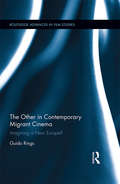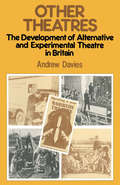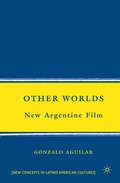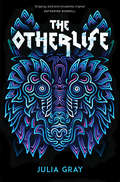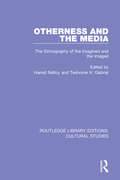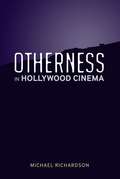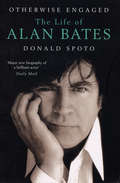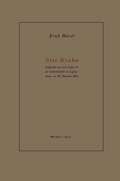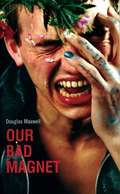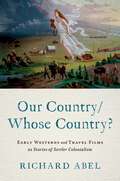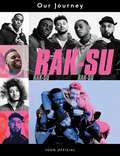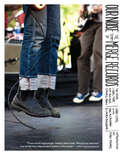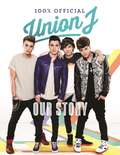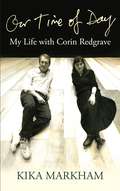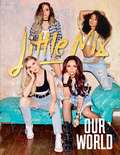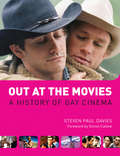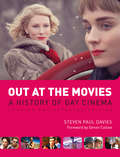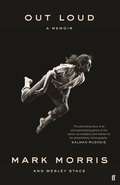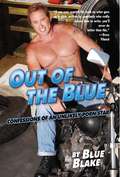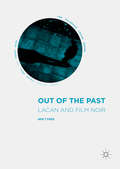- Table View
- List View
The Other in Contemporary Migrant Cinema: Imagining a New Europe? (Routledge Advances in Film Studies)
by Guido RingsAs a rapidly aging continent, Europe increasingly depends on the successful integration of migrants. Unfortunately, contemporary political and media discourses observe and frequently also support the development of nationalist, eurosceptic and xenophobic reactions to immigration and growing multiethnicity. Confronting this trend, European cinema has developed and disseminated new transcultural and postcolonial alternatives that might help to improve integration and community cohesion in Europe, and this book investigates these alternatives in order to identify examples of good practices that can enhance European stability. While the cinematic spectrum is as wide and open as most notions of Europeanness, the films examined share a fundamental interest in the Other. In this qualitative film analysis approach, particular consideration is given to British, French, German, and Spanish productions, and a comparison of multiethnic conviviality in Chicano cinema.
The Other in Contemporary Migrant Cinema: Imagining a New Europe? (Routledge Advances in Film Studies #46)
by Guido RingsAs a rapidly aging continent, Europe increasingly depends on the successful integration of migrants. Unfortunately, contemporary political and media discourses observe and frequently also support the development of nationalist, eurosceptic and xenophobic reactions to immigration and growing multiethnicity. Confronting this trend, European cinema has developed and disseminated new transcultural and postcolonial alternatives that might help to improve integration and community cohesion in Europe, and this book investigates these alternatives in order to identify examples of good practices that can enhance European stability. While the cinematic spectrum is as wide and open as most notions of Europeanness, the films examined share a fundamental interest in the Other. In this qualitative film analysis approach, particular consideration is given to British, French, German, and Spanish productions, and a comparison of multiethnic conviviality in Chicano cinema.
Other Theatres: Development of Alternative and Experimental Theatre in Britain (Communication And Culture Ser.)
by Andrew DaviesOther Worlds: New Argentine Film (New Directions in Latino American Cultures)
by G. AguilarRespected film critic Gonzalo Aguilar offers a lucid and sophisticated analysis of Argentine films of the last decade. This is the most complete and up-to-date work in English to examine the 'new Argentine cinema' phenomenon. Aguilar looks at highly relevant films, including those by Lucrecia Martel and Sergio Rejtman.
The Otherlife
by Julia GrayI always get away with it when I try stuff like this. Partly it comes down to sort of assuming that I'm going to. I've got loads of confidence. And Loki got away with everything. Well, almost everything.When troubled, quiet Ben begins at the ruthlessly competitive Cottesmore House, school to the richest, most privileged boys, he is befriended by Hobie: the wealthy class bully, product of monstrous indulgence and intense parental ambition. Hobie is drawn to Ben because he can see the Otherlife: a violent, mythic place where gods and monsters roam. Ben has unnerving visions of Thor and Odin, and of the giant beasts that will destroy them, as well as Loki, god of mischief. Hobie is desperate to be a part of it.Years later, Ben discovers someone very dear to him is dead. And he can’t help wondering if Hobie – wild, restless, dangerous Hobie, had something to do with it…Beguiling, shocking and richly imaginative, The Otherlife is about the darkest impulses within us all.
Otherness and the Media: The Ethnography of the Imagined and the Imaged (Routledge Library Editions: Cultural Studies)
by Hamid Naficy and Teshome H. GabrielThis anthology on otherness and the media, first published in 1993, was prompted by the proliferation of writings centring on issues of ‘difference’, ‘diversity’, ‘multiculturalism’, ‘representation’ and ‘postcolonial’ discourses. Such issues and discourses question existing canons of criticism, theory and cultural practice but also because they suggest a new sense of direction in theorisation of difference and representation.
Otherness and the Media: The Ethnography of the Imagined and the Imaged (Routledge Library Editions: Cultural Studies)
by Hamid Naficy Teshome H. GabrielThis anthology on otherness and the media, first published in 1993, was prompted by the proliferation of writings centring on issues of ‘difference’, ‘diversity’, ‘multiculturalism’, ‘representation’ and ‘postcolonial’ discourses. Such issues and discourses question existing canons of criticism, theory and cultural practice but also because they suggest a new sense of direction in theorisation of difference and representation.
Otherness in Hollywood Cinema
by Michael RichardsonIn Otherness in Hollywood Cinema, Michael Richardson argues that the Hollywood system has been the only national cinema with the resources and inclination to explore images of others through stories set in exotic and faraway places. He traces many of the ways in which Hollywood has constructed otherness, and discusses the extent to which those images have persisted and conditioned today's understanding. Hollywood was from the beginning teeming with people who had experienced cultural displacement. Coaxing the finest talents from around the world and needing to produce films with an almost universal appeal, Hollywood confounded American insularity while simultaneously presenting a vision of 'America' to the world.The book examines a range of genres from the perspective of otherness, including the Western, film noir, and zombie movies. Films discussed include Birth of a Nation, The New World, The Searchers, King Kong, Apocalypse Now, Blade Runner, Jaws, and Dead Man. Erudite and highly informed, this is a sweeping survey of how the American film industry has portrayed the foreign and the exotic.
Otherwise Engaged: The Life of Alan Bates
by Donald SpotoIn 1956, at the age of 22, Alan Bates was cast in John Osborne's controversial play, Look Back in Anger. The play changed the course of British theatre - and of Alan's life. With a sudden rush of fame, he became a member of a new circle of actors at the Royal Court: the English Stage Company. From then on, he also worked steadily in television and won international acclaim for his roles in a number of major films, from A Kind of Loving and Zorba the Greek to Women in Love. But his personal life was not always as seemingly straightforward as his career - his relationships, including that with his wife, Victoria Ward, were often turbulent. Drawing on dozens of interviews with his family, lovers, colleagues and friends - and mining a rich store of primary research - Donald Spoto chronicles Alan's achievements as a performer against the backdrop of a complicated personal life.
Otto Brahm: Gefprochen von Lina Loffen bei der Gedächtnisfeier im Leffing-theater am 22. Dezember 1912
by Ernst HardtDieser Buchtitel ist Teil des Digitalisierungsprojekts Springer Book Archives mit Publikationen, die seit den Anfängen des Verlags von 1842 erschienen sind. Der Verlag stellt mit diesem Archiv Quellen für die historische wie auch die disziplingeschichtliche Forschung zur Verfügung, die jeweils im historischen Kontext betrachtet werden müssen. Dieser Titel erschien in der Zeit vor 1945 und wird daher in seiner zeittypischen politisch-ideologischen Ausrichtung vom Verlag nicht beworben.
Our Bad Magnet (Oberon Modern Plays)
by Douglas MaxwellOur Bad Magnet is an unashamedly dark and deliciously funny play from one of Scotland's brightest young writing talents, in which the boundaries between fantasy and reality merge with unpredictable results.Centering on an uneasy reunion, Our Bad Magnet follows the progress of four boys from 9 to 29 as they try to unlock the secrets of childhood and memory. Throw in 1980s indie music, a ventriloquist's dummy, some magical fairy stories and the word 'nimston', and you have an hilarious black comedy which isn't afraid to make you think while you're laughing out loud.
Our Country/Whose Country?: Early Westerns and Travel Films as Stories of Settler Colonialism
by Richard AbelThe concept of settler colonialism offers an invaluable lens to reframe early westerns and travel pictures as re-enactments of the United States' repressed past. Westerns in particular propose a remarkable vision of white settlers' westward expansion that reveals a transformation in what "American Progress" came to mean. Initially, these films tracked settlers moving westward across the Appalachians, Great Plains, and Rockies. Their seizure of "empty land" provoked continual resistance from Indigenous peoples and Mexicans; "pioneers" suffered extreme hardships, but heroic male figures usually scattered or wiped out those "aliens." Some films indulged in nostalgic empathy for the Indian as a "Vanishing American." In the early 1910s, westerns became increasingly popular. In Indian pictures, Native Americans ranged from devious savages, victims of white violence, and "Noble Savages" to "in-between" figures caught between cultures and "mixed-descent peoples" partnered for security or advantage. Mexicans took positions across a similar spectrum. In cowboy and cowgirl films, "ordinary" whites became heroes and heroines fighting outlaws; and bandits like Broncho Billy underwent transformation into "good badmen." The mid to late 1910s saw a shift, as Indian pictures and cowgirl films faded and male figures, embodied by movie stars, dominated popular series. In different ways, William S. Hart and Harry Carey reinvented the "good badman" as a stoic, if troubled, figure of white masculinity. In cowboy films of comic romance, Tom Mix engaged in dangerous stunts and donned costumes that made him a fashionable icon. In parodies, Douglas Fairbanks subverted the myth of "American Progress," sporting a nonchalant grin of effortless self-confidence. Nearly all of their films assumed firmly settled white communities, rarely threatened by Indians or Mexicans. Masked as "Manifest Destiny," the expropriation of the West seemed settled once and for all. Our Country/Whose Country? offers a rich and expansive examination of the significance of early westerns and travel pictures in the ideological foundations of "our country."
Our Country/Whose Country?: Early Westerns and Travel Films as Stories of Settler Colonialism
by Richard AbelThe concept of settler colonialism offers an invaluable lens to reframe early westerns and travel pictures as re-enactments of the United States' repressed past. Westerns in particular propose a remarkable vision of white settlers' westward expansion that reveals a transformation in what "American Progress" came to mean. Initially, these films tracked settlers moving westward across the Appalachians, Great Plains, and Rockies. Their seizure of "empty land" provoked continual resistance from Indigenous peoples and Mexicans; "pioneers" suffered extreme hardships, but heroic male figures usually scattered or wiped out those "aliens." Some films indulged in nostalgic empathy for the Indian as a "Vanishing American." In the early 1910s, westerns became increasingly popular. In Indian pictures, Native Americans ranged from devious savages, victims of white violence, and "Noble Savages" to "in-between" figures caught between cultures and "mixed-descent peoples" partnered for security or advantage. Mexicans took positions across a similar spectrum. In cowboy and cowgirl films, "ordinary" whites became heroes and heroines fighting outlaws; and bandits like Broncho Billy underwent transformation into "good badmen." The mid to late 1910s saw a shift, as Indian pictures and cowgirl films faded and male figures, embodied by movie stars, dominated popular series. In different ways, William S. Hart and Harry Carey reinvented the "good badman" as a stoic, if troubled, figure of white masculinity. In cowboy films of comic romance, Tom Mix engaged in dangerous stunts and donned costumes that made him a fashionable icon. In parodies, Douglas Fairbanks subverted the myth of "American Progress," sporting a nonchalant grin of effortless self-confidence. Nearly all of their films assumed firmly settled white communities, rarely threatened by Indians or Mexicans. Masked as "Manifest Destiny," the expropriation of the West seemed settled once and for all. Our Country/Whose Country? offers a rich and expansive examination of the significance of early westerns and travel pictures in the ideological foundations of "our country."
Our Joe: Joe Dolan by the People who Knew him Best
by Eddie RowleyRead the story of Joe through his own interviews and the memories and anecdotes of his family, including his brother Ben who was by his side in showbusiness for over forty years; his band members, including his nephews Adrian and Ray; his showbiz pals, Larry Gogan, Finbar Furey, Brendan Bowyer and Paddy Cole; his fans, friends (including Michael O’Leary of Ryanair) and acquaintances from all walks of life. Jam-packed with a treasure trove of never-before-told stories that vividly bring to life the essence of Joe Dolan: the showbiz legend, the family man, the friend, the joker and the devil-may-care character who never forgot his roots or lost touch with his people despite enjoying fame and wealth beyond his dreams.
Our Journey
by Rak-SuRAK-WHAT? RAK-SU!___________Rak-Pack! Are you ready for our official story?As long as we've been friends, we've been creating our unique sound of soul, R'n'B, Hip-Hop, Latin and Caribbean music.Keeping the momentum going from our X-Factor journey, we are now performing at sold-out arenas, making more music and having fun!So why not join us on the adventure? Unrivalled access to never-before-seen photos, intimate stories, and behind-the-scenes info - in our first and only memoir!_________Ashley, Jamaal, Myles and Mustafa shot to stardom in 2017 as the first ever male group to win the X-Factor. Since then, the soulful boys have been topping the charts with their eclectic sound, performing at sold-out arenas, touring with global sensation Little Mix, recording their first album and most recently dropping their brand new hit single, Pyro Ting.Join Rak-Su on their journey from ordinary North-West London lads, to victors of one of the world's biggest talent shows in their one and ONLY! OFFICIAL memoir, Our Journey.
Our Noise: The Story of Merge Records, the Indie Label That Got Big and Stayed Small
by Laura Ballance John Cook Mac McCaughanMerge Records defies everything you’ve heard about the music business. Started by two twenty-year-old musicians, Merge is a lesson in how to make and market great music on a human scale. The fact that the company is prospering in a failing industry is something of a miracle. Yet two of their bands made the Billboard Top 10 list; more than 1 million copies of Arcade Fire's Neon Bible have been sold; Spoon has appeared on Saturday Night Live and The Tonight Show; and the Magnetic Fields' 69 Love Songs is a contemporary classic. In celebration of their twentieth anniversary, founders Mac and Laura offer first-person accounts—with the help of their colleagues and Merge artists—of their work, their lives, and the culture of making music. Our Noise also tells the behind-the-scenes stories of Arcade Fire, Spoon, the Magnetic Fields, Superchunk, Lambchop, Neutral Milk Hotel, and Butterglory. Hundreds of personal photos of the bands, along with album cover art, concert posters, and other memorabilia are included.
Our Story: Union J 100% Official
by Union JJoin Union J as they embark on their journey to become THE next big boyband in Our Story!Only a few months ago Union J were just average guys, dreaming of performing on the X Factor stage, making music and having legions of fans screaming their names. And now that dream has become a reality.Follow Union J's unique journey from ordinary boys to stars as one of the most popular acts on X Factor 2012, in their first official memoir. Packed full of exclusive photos, behind-the-scenes gossip and the individual stories of JJ, Jaymi, Josh and George, Union J's Our Story is the book is a must-have for all J-Cats!Union J shot to stardom after reaching the X Factor finals in 2012. Jaymi, Josh and JJ had originally auditioned as a three piece called Triple J, but Louis selected soloist George to join the group, recognising their potential as a four. They have since played to sold out arenas around the country on the X Factor tour, signed a record deal with Sony Music and recorded their first single to be released in June 2013.
Our Time of Day: My Life with Corin Redgrave (Oberon Modern Plays)
by Kika Markham‘I remember thinking if life had been different, I might have liked to have ended up with that man.’ Our Time of Day was inspired by Corin’s revelation that after suffering brain damage he could remember little of his marriage – despite the fact that for over thirty happy, passionate and turbulent years he and Kika had shared their love of acting, family and left-wing politics with ceaseless energy and commitment. With great empathy and wit, Kika records their lives on and off stage – two great actors from two theatrical families. She draws upon intimate records of the thoughts and feelings that they had both expressed in personal diaries, writing with often brutal honesty. Finally she charts the poignant trajectory of Corin’s illness, from the moment he suffered a near-fatal heart attack during a speech on behalf of the Dale Farm gypsies, to severe memory loss, cancer and his eventual death from an aneurysm in the brain. Throughout these troubled years both continued acting in plays and films, as well as strenuously pursuing the human rights causes they held so dear.
Our World: Our OFFICIAL autobiography
by Little MixCelebrate Little Mix's first UK number-one album - Glory Days - by reading the full story of the girls' astonishing rise to pop super stardom. Our World is full of exclusive photos and inspirational stories about Jade, Perrie, Jesy and Leigh-Anne's unique friendship.Little Mix are the UK's most successful girl band. They first found fame - and each other - on The X Factor in 2011. Five years later they have gone from strength to strength, achieving huge global success. With three platinum-selling albums in the UK and over 14 million record sales worldwide, the band are both adored by their fans and critically acclaimed for their brilliant music. In this book the girls share the real behind-the-scenes story of both their personal lives and their success. They reveal the many highs - what it feels like to perform in front of thousands of people; the excitement of seeing your music soar to Number One around the world - but also the lows. Through it all the girls have had each other, and their incredibly close friendship has grown stronger and stronger as the years have gone by. Now the girls are like sisters, and in this book they share their journeys and how it feels for your dreams to come true.Brimming with exclusive photos, this book shares with us the girls' innermost secrets - their hopes and dreams for the future, their families, their relationships, their style advice and above all their friendship. This book is Little Mix's story in their own words and tells you everything you need to know about their lives both in and out of the spotlight.
Out at the Movies: A History Of Gay Cinema
by Steven Paul DaviesOver the decades, gay cinema has reflected the community's journey from persecution to emancipation to acceptance. Politicised dramas like Victim in the 60s, The Naked Civil Servant in the 70s, and the AIDS cinema of the 80s have given way in recent years to films which celebrate a vast array of gay life-styles. Gay films have undergone a major shift, from the fringe to the mainstream and the 2005 Academy Awards were dubbed ' the Gay Oscars' with gongs going to Brokeback Mountain, Capote and Transamerica. Producers began clamouring to back gay-themed movies, including I Love You Philip Morris with Jim Carey and Ewan McGregor, and Gus Van Sant's Milk, starring Sean Penn as Harvey Milk, the first prominent American political figure to be elected to office on an openly gay ticket back in the 70s. So loved was he that his brutal and homophobic assassination by ex-policeman Daniel White sparked the biggest riots in gay history. Out at the Movies looks back, decade by decade, at the history of gay cinema, celebrating the films which have defined the genre. Indie films, the avant-garde, sex on screen, bad guys, lesbian lovers, transgender films, camp comedies, musicals and gay rom-coms -- all are featured here. As well as highloighting the key movements and triumphs in gay cinema, the author includes information on gay filmmakers and actors, and their influence within the industry. Interspersed throughout are some of the most iconic scenes from gay cinema and the most memorable dialogue.
Out at the Movies: A History of Lesbian, Gay, Bisexual, Transexual and Queer Cinema
by Steven Paul Davies'This is a must for any fan of gay movies... Out at the Movies is the ultimate guide to gay cinema and the films that define it' - Zone Magazine 'A new book about homosexuality on film will strike chords with many bashful Brits' - Guardian New updated edition. Over the decades, gay cinema has reflected the community's journey from persecution to emancipation to acceptance. Politicised dramas like Victim in the 60s, The Naked Civil Servant in the 70s, and the AIDS cinema of the 80s have given way in recent years to films which celebrate a vast array of gay life-styles. Gay films have undergone a major shift, from the fringe to the mainstream and 2005's Academy Awards were dubbed "the Gay Oscars" with gongs going to Brokeback Mountain, Capote and Transamerica. Producers began clamouring to back gay-themed movies, including I Love You Phillip Morris with Jim Carrey and Ewan McGregor, Gus Van Sant's Milk, starring Sean Penn, the feel good British movie Pride and The Imitation Game with Benedict Cumberbatch and Carol which is nominated for six Oscars. In this revised, expanded and completely up to date edition, Out at the Movies looks back, decade by decade, at the history of gay cinema, celebrating films which have defined the genre. Indie films, the avant-garde, sex on screen, bad guys, lesbian lovers, transgender films, camp comedies, musicals and gay rom-coms - all are featured here. As well as highlighting key movements and triumphs in gay cinema, the author includes information on gay filmmakers and actors, and their influence within the industry. Interspersed throughout are some of the most iconic scenes from gay cinema and the most memorable dialogue.
Out Loud: A Memoir
by Mark Morris Wesley StaceBefore Mark Morris became "the most successful and influential choreographer alive" (The New York Times), he was a six year-old in Seattle cramming his feet into Tupperware glasses so that he could practice walking on pointe. Moving to New York at nineteen, he arrived to one of the great booms of dance in America. . Morris was flat broke but found a group of likeminded artists that danced together, travelled together, slept together. This collective, led by Morris's fiercely original vision, became the famed Mark Morris Dance Group.Suddenly, Morris was making a fast ascent. Celebrated by The New Yorker's critic as one of the great young talents, an androgynous beauty in the vein of Michelangelo's David, he and his company had arrived. Collaborations with the likes of Mikhail Baryshnikov, Yo-Yo Ma, Lou Harrison, and Howard Hodgkin followed. And so did controversy: from the circus of his tenure at La Monnaie in Belgium to his work on the biggest flop in Broadway history. But through the Reagan-Bush era, the worst of the AIDS epidemic, through rehearsal squabbles and backstage intrigues, Morris emerged as one of the great visionaries of modern dance, a force of nature with a dedication to beauty and a love of the body, an artist as joyful as he is provocative.Out Loud is the bighearted and outspoken story of a man as formidable on the page as he is on the boards. With unusual candor and disarming wit, Morris's memoir captures the life of a performer who broke the mold, a brilliant misfit who found his home in the collective and liberating world of music and dance.
Out of Line: A Memoir
by Dov Fedler"You'll be a dentist," says Dad. "Why?" I ask. "Because you'll be called doctor and you won't be called out at night." "I'm not sticking my hands down anyone's mouth. Yech!" DOV FEDLER was a laatlammetjie, born and bred in Johannesburg in 1940 just as Hitler was getting into his stride. A third child was not on his parents' 'want-list'. It was hard enough supporting two much older children and a printing business struggling to exist. When Dov was about three his mother had a 'nervous breakdown' which is when he remembers seeing his first pencil and knowing precisely what it was that he wanted to do with his life. There are no coincidences in Dov's life. He believes that a hand of destiny has steered his path. Many dramatic encounters (not with aliens or spirits, but with everyday people) have shaped him and he wouldn't have missed any of it. Dov's story is intensely personal and honest, with a powerful combination of humour, emotion and community history. OUT OF LINE attempts to do a few short things. It is an autobiography but it is also an attempt to capture a particular history of a specific generation; that of the Jewish baby boomers who descended from mainly Lithuanian stock. Dov has been a leading South African cartoonist for more than 45 years, and his earliest dream was to work for Walt Disney. He has always known his career was somewhere in drawing. He got to visit Disney World and could not wait to leave. He has never been to Europe or Brakpan and is a pure product of Johannesburg. The last on his wish list was to become a political cartoonist.
Out of the Blue: Confessions of an Unlikely Porn Star
by Blue BlakeGayporn.com's JC Adams praises: "Blue Blake's picaresque memoir is outrageous, deranged and filthily funny. You don't have to be a porn biz insider to savor his dishy anecdotes and behind-the-scenes gossip." Out of the Blue is a hilarious autobiographical romp that details the life of porn star turned director/producer Blue Blake and his adventures in the skin trade. Blue has worked with every major star in the industry and won many major awards and honors, including induction into the Gay Porn Legend Hall of Fame.
Out of the Past: Lacan and Film Noir (The Palgrave Lacan Series)
by Ben TyrerThis book presents a new reading of film noir through psychoanalytic theory. In a field now dominated by Deleuzian and phenomenological approaches to film-philosophy, this book argues that, far from having passed, the time for Lacan in Film Studies is only just beginning. The chapters engage with Lacanian psychoanalysis to perform a meta-critical analysis of the writing on noir in the last seven decades and to present an original theory of criticism and historiography for the cinema. The book is also an act of mourning; for a lost past of the cinema, for a longstanding critical tradition and for film noir. It asks how we can talk about film noir when, in fact, film noir doesn’t exist. The answer starts with Lacan and a refusal to relinquish psychoanalysis. Lacanian theories of retroactivity and ontology can be read together with film history, genre and narrative to show the ways in which theory and history, past and present, cinema and psychoanalysis are fundamentally knotted together. Tyrer also explores Lacan through particular noir films, such as Double Indemnity andThe Maltese Falcon — and demonstrates the possibilities for a Lacanian Film Studies (as one that engages fully with Lacan’s entire body of work) that has hitherto not been realised.
